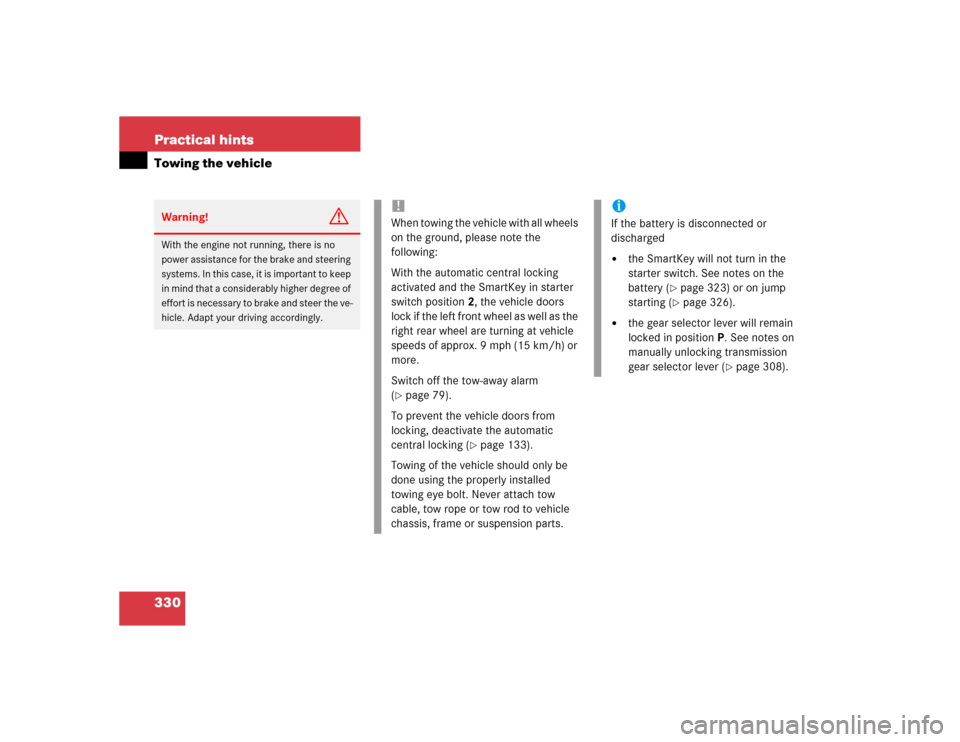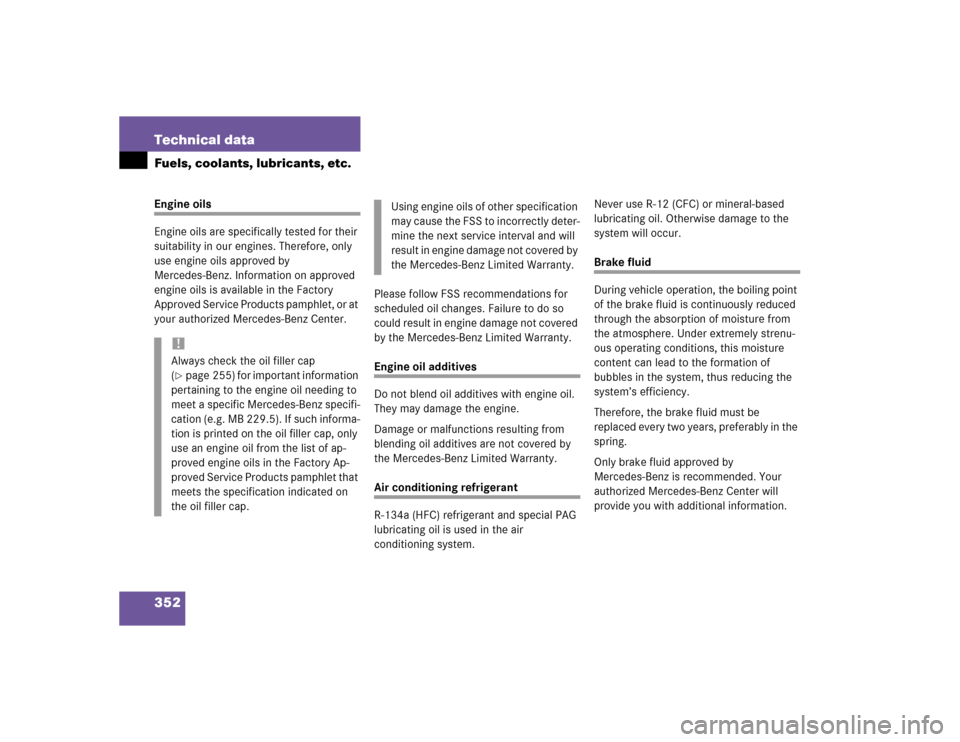Page 330 of 400

330 Practical hintsTowing the vehicleWarning!
G
With the engine not running, there is no
power assistance for the brake and steering
systems. In this case, it is important to keep
in mind that a considerably higher degree of
effort is necessary to brake and steer the ve-
hicle. Adapt your driving accordingly.
!When towing the vehicle with all wheels
on the ground, please note the
following:
With the automatic central locking
activated and the SmartKey in starter
switch position2, the vehicle doors
lock if the left front wheel as well as the
right rear wheel are turning at vehicle
speeds of approx. 9 mph (15 km/h) or
more.
Switch off the tow-away alarm
(�page 79).
To prevent the vehicle doors from
locking, deactivate the automatic
central locking (
�page 133).
Towing of the vehicle should only be
done using the properly installed
towing eye bolt. Never attach tow
cable, tow rope or tow rod to vehicle
chassis, frame or suspension parts.
iIf the battery is disconnected or
discharged�
the SmartKey will not turn in the
starter switch. See notes on the
battery (
�page 323) or on jump
starting (�page 326).
�
the gear selector lever will remain
locked in positionP. See notes on
manually unlocking transmission
gear selector lever (
�page 308).
Page 333 of 400
333 Practical hintsFuses
Fuse box in engine compartment
The fuse box is located in the engine
compartment on the left hand side.
1Screw
2Cover
3RetainerRemoving/installing cover
�
Twist screws1
90° counterclockwise.
�
Pull up cover2.
�
Slide out retainer3 and remove cover
by pulling towards front.
�
Install cover2 in reverse order.Opening fuse box
4Fuse box cover
5Clamps
�
Release clamps5.
�
Remove cover4.
Closing fuse box
�
Ensure that the sealing rubber is
properly positioned.
�
Press cover4 down and secure with
clamps5.
Page 335 of 400
335 Technical data
Spare parts service
Warranty coverage
Identification labels
Layout of poly-V-belt drive
Engine
Rims and Tires
Electrical system
Main dimensions
Weights
Fuels, coolants, lubricants, etc.
Consumer information
Page 338 of 400
338 Technical dataIdentification labels
�Identification labels1Certification label2Vehicle Identification Number (VIN)3Information label, California version
Vacuum line routing for emission
control system
4Engine number (engraved on engine)
5VIN, visible (lower edge of windshield)
6Emission control label
When ordering spare parts, please specify
vehicle identification and engine numbers.
Page 340 of 400
340 Technical dataEngine
�EngineModel
C 230 Kompressor Sport (203.040)
1
1The quoted data apply only to the standard vehicle. See an authorized Mercedes-Benz Center for the corresponding data of all special bodies and special equipment.
C 240 (203.061)
1
C 240 4MATIC (203.081)
1
Engine
271
112
Mode of operation
4-stroke engine, gasoline injection
4-stroke engine, gasoline injection
No. of cylinders
4
6
Bore
3.23 in (82.00 mm)
3.54 in (89.90 mm)
Stroke
3.35 in (85.00 mm)
2.68 in (68.20 mm)
Total piston displacement
109.6 cu in (1 796 cm
3)
158.5 cu in (2 597 cm
3)
Compression ratio
8.5:1
10.5:1
Output acc. to SAE J 1349
189 hp/5 800 rpm
(141 kW/5 800 rpm)
168 hp/5 500 rpm
(125 kW/5 500 rpm)
Maximum torque acc. to SAE J 1349
192 lb-ft/3 500 - 4 000 rpm
(260 Nm/3 500 - 4 000 rpm)
177 lb-ft/4 500 rpm
(240 Nm/4 500 rpm)
Maximum engine speed
6000 rpm
6200 rpm
Firing order
1-3-4-2
1-4-3-6-2-5
Poly-V-belt
2420 mm
2380 mm
Page 341 of 400
341 Technical data
Engine
Model
C 320 (203.064)
1
C 320 4MATIC (203.084)
1
C 320 Sport (203.064)
1
C32AMG(203.065)
1
Engine
112
112
Mode of operation
4-stroke engine, gasoline injection
4-stroke engine, gasoline injection
No. of cylinders
6
6
Bore
3.54 in (89.90 mm)
3.54 in (89.90 mm)
Stroke
3.31 in (84.00 mm)
3.31 in (84.00 mm)
Total piston displacement
195.2 cu in (3 199 cm
3)
195.2 cu in (3 199 cm
3)
Compression ratio
10:1
9:1
Output acc. to SAE J 1349
215 hp/5 700 rpm
(160 kW/5 700 rpm)
349 hp/6 100 rpm
(260 kW/6 100 rpm)
Maximum torque acc. to SAE J 1349
229 lb-ft/3 000 - 4 600 rpm
(310 Nm/3 000 - 4 600 rpm)
332 lb-ft/4 400 rpm
(450 Nm/4 400 rpm)
Maximum engine speed
6000 rpm
6 200 rpm
Firing order
1-4-3-6-2-5
1-4-3-6-2-5
Poly-V-belt
2380 mm
2 908 mm
1The quoted data apply only to the standard vehicle. See an authorized Mercedes-Benz Center for the corresponding data of all special bodies and special equipment.
Page 349 of 400
349 Technical data
Fuels, coolants, lubricants, etc.
�Fuels, coolants, lubricants, etc.
Capacities
Vehicle components and their respectivelubricants must match. Therefore only use
brands tested and approved by
Mercedes-Benz. Please refer to the Factory Approved
Service Products pamphlet, or inquire at
your Mercedes-Benz Center.
Model
Capacity
Fuels, coolants, lubricants, etc.
Engine with oil filter
C 230 Kompressor Sport
C240
C320
C320Sport
C2404MATIC
C3204MATIC
C32AMG
5.8 US qt (5.5 l)
7.9 US qt (7.5 l)
7.9 US qt (7.5 l)
7.9 US qt (7.5 l)
7.4 US qt (7.0 l)
7.4 US qt (7.0 l)
7.9 US qt (7.5 l)
Approved engine oils
Automatic transmission
8.5 US qt (8.0 l)
MB Automatic Transmission Oil
Manual transmission
1.3 US qt (1.2 l)
MB Manual Transmission Oil
Rear axle
C 230 Kompressor Sport
C 240 (all models)
C 320 (all models)
C32AMG
1.2 US qt (1.1 l)
1.2 US qt (1.1 l)
1.2 US qt (1.1 l)
1.5 US qt (1.4 l)
Hypoid gear oil SAE 85 W 90
Page 352 of 400

352 Technical dataFuels, coolants, lubricants, etc.Engine oils
Engine oils are specifically tested for their
suitability in our engines. Therefore, only
use engine oils approved by
Mercedes-Benz. Information on approved
engine oils is available in the Factory
Approved Service Products pamphlet, or at
your authorized Mercedes-Benz Center.Please follow FSS recommendations for
scheduled oil changes. Failure to do so
could result in engine damage not covered
by the Mercedes-Benz Limited Warranty.
Engine oil additives
Do not blend oil additives with engine oil.
They may damage the engine.
Damage or malfunctions resulting from
blending oil additives are not covered by
the Mercedes-Benz Limited Warranty.Air conditioning refrigerant
R-134a (HFC) refrigerant and special PAG
lubricating oil is used in the air
conditioning system.Never use R-12 (CFC) or mineral-based
lubricating oil. Otherwise damage to the
system will occur.
Brake fluid
During vehicle operation, the boiling point
of the brake fluid is continuously reduced
through the absorption of moisture from
the atmosphere. Under extremely strenu-
ous operating conditions, this moisture
content can lead to the formation of
bubbles in the system, thus reducing the
system’s efficiency.
Therefore, the brake fluid must be
replaced every two years, preferably in the
spring.
Only brake fluid approved by
Mercedes-Benz is recommended. Your
authorized Mercedes-Benz Center will
provide you with additional information.
!Always check the oil filler cap
(�page 255) for important information
pertaining to the engine oil needing to
meet a specific Mercedes-Benz specifi-
cation (e.g. MB 229.5). If such informa-
tion is printed on the oil filler cap, only
use an engine oil from the list of ap-
proved engine oils in the Factory Ap-
proved Service Products pamphlet that
meets the specification indicated on
the oil filler cap.
Using engine oils of other specification
may cause the FSS to incorrectly deter-
mine the next service interval and will
result in engine damage not covered by
the Mercedes-Benz Limited Warranty.